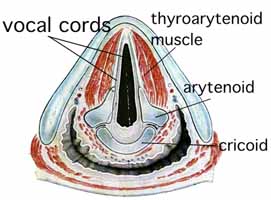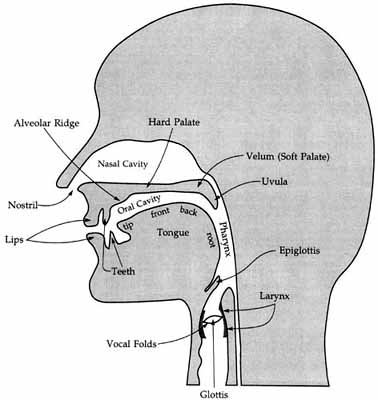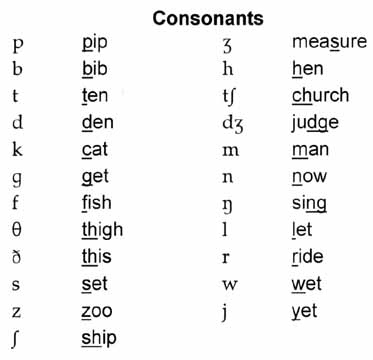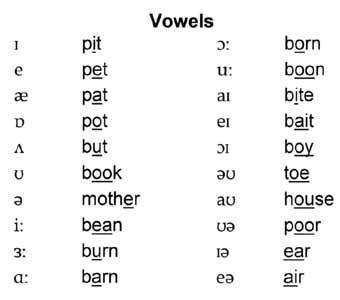A Beginner's Guide to Phonetics
By Jean Peccei
This page is adapted from my lectures on introductory phonetics at Roehampton University, where I teach on the English Language & Linguistics Programme.
Some basic anatomy When speaking (or singing), air from the lungs first passes through the larynx (in everyday language - the voice box, or Adam's apple). Inside the larynx are two tiny but very important membranes, commonly called vocal cords, but usually referred to as vocal folds by phoneticians. These membranes are set into vibration by the passing air, producing sound. They are controlled by a set of muscles and cartilage which allows them to change their shape, and consequently the quality of sound they produce, including changes in pitch. The vocal folds can also be kept from vibrating by keeping them completely open or completely shut. The vocal folds and the opening between them is called the glottis. Figure 1 below shows the larynx seen from above with the vocal cords/folds and their associated cartilages (thyroarytenoid, arytenoid and cricoid) and muscle..

Figure 1. The larynx
Source: Department of Otolaryngology, University of Washington
Once the vibrating column of air had passed through the larynx, its shape can be molded into different sounds as it passes through the vocal tract. See Figure 2 below

Figure 2. The vocal tract
Source: Department of Linguistics, University of Pennsylvania
Speech sounds Every language has a unique set of sounds, its phonemes, that are used to build its words. These sounds are contrastive. That is, they differentiate between words. Compare these English word pairs which differ in only one of their phonemes:
sat/set sin/sit mop/top
Languages vary in terms of the number of distinct phonemes they use. English, for example, has approximately 44 phonemes (depending on the accent), while Italian has approximately 25.
When describing and analyzing the sound systems of languages, linguists use the International Phonetic Alphabet or IPA. In this alphabet each sound is given a unique symbol which allows us to capture similarities and differences that are obscured by the written form. For example, the first sounds of kit and
cut are identical, although they are spelled with different letters - c and k. On the other hand, the sounds written with the letter y in silly and young are completely different from each other. The chart below illustrates the IPA symbols for the consonants and vowels of the standard British English accent
cut are identical, although they are spelled with different letters - c and k. On the other hand, the sounds written with the letter y in silly and young are completely different from each other. The chart below illustrates the IPA symbols for the consonants and vowels of the standard British English accent


Classifying speech sounds Speech sounds are of two major types - vowels and consonants. Here we look at each of these major types in a bit more detail.
_______________
Vowels are speech sounds produced with no obstruction to the air flow coming from the lungs. Vowels take on their different sound qualities by subtle changes of shape in the vocal tract as they are being produced. For example, in producing the vowel sound /i:/ as in bean, the lower and upper jaw are quite close together and the front part of the tongue is slightly raised towards the roof of the mouth, while in producing /u:/ as in boon, it is the back part of the tongue is raised. In producing /a:/ as in barn, the jaws are quite far apart, and it is the central part of the tongue which is slightly raised. Vowels are also differentiated by the degree to which the lips are rounded or spread, e.g. /i:/ is made with spread lips, /u:/
with rounded lips and /a:/ with the lips in a neutral position. Finally, vowels will vary in terms of their length - how long they are held. The /e/ in pet is short vowel compared to the /u:/ in boon. (The : after a vowel symbol indicates that it is a long vowel.).
with rounded lips and /a:/ with the lips in a neutral position. Finally, vowels will vary in terms of their length - how long they are held. The /e/ in pet is short vowel compared to the /u:/ in boon. (The : after a vowel symbol indicates that it is a long vowel.).
'Pure' vowels vs diphthongs. A diphthong is a long, complex vowel which starts with the sound quality of one vowel and ends with the sound quality of another one. Although they are classified as single phonemes, diphthongs are given a double symbol to show both the quality they start with and the quality they end with. The English diphthongs in the chart above are illustrated in the words bite, bait, boy, toe, house, poor, ear, and air. Languages vary in their use of diphthongs. For example, English has several, while Italian has none.
_______________
Consonants are speech sounds that involve a momentary interruption or obstruction of the air flow. Consonants can be described and differentiated from each other by using three main classifications: voice,
place, and manner of articulation..
place, and manner of articulation..
1. Voice: Are the vocal cords vibrating when they are produced? Both /p/ and /b/ are made by closing the lips briefly to stop the flow of air and then releasing it. The only difference between them is that
/b/ is voiced while /p/ is not. But what a key difference this voicing contrast makes linguistically! Would you rather receive a bat on the head or a pat on the head?
/b/ is voiced while /p/ is not. But what a key difference this voicing contrast makes linguistically! Would you rather receive a bat on the head or a pat on the head?
2. Place of articulation: Where in the vocal tract is the air flow obstructed? The vocal tract extends from the lips all the way back to the glottis. (See Figure 2 above) The main places of articulation that are used to contrast phonemes in English, starting from the front of the vocal tract, are:
labial (lips) - as in the first and last consonants of pip
labio-dental (teeth and lips) - as in first consonant of fish
dental (sometimes called linguo-dental since in English these consonants are formed by placing the
tongue between the teeth) - as in the first consonant of this (Note that even though in the written form of
this, that sound is spelled with two letters, t and h, it is a single phoneme)
alveolar (the bumpy ridge just behind your upper teeth) - as in the first and last consonants of ten
post-alveolar (sometimes called palato-alveolar since it is the area between the alveolar ridge and the
hard palate) - as in the first consonant of ship. (Again, note that this is a single phoneme although in the
written form it is often spelled with two letters, s and h.)
palatal (hard palate, or 'roof' of the mouth') - as in the first consonant of yet
velar (soft palate or velum which can open or close to control airflow into the nasal cavity) - as in the first
consonant of cat.
glottal (glottis, the vocal cords and the opening between them) - as in the first consonant of hen
3. Manner of articulation: To what degree is the air flow obstructed? Consonants can involve a complete obstruction of the airflow as in /p/ or /k/ all the way down a very minimal obstruction as in /w/ or /j/. The main manners of articulation that are used to contrast phonemes in English, starting with those requiring the most obstruction, are:
plosive (complete obstruction followed by release) - as in the first consonant of ten
fricative (very close but not complete obstruction involving friction) - as in the first consonant of set
affricate (very close obstruction where the consonant begins as a plosive and ends as a fricative - the
double symbol indicates both the quality it starts with the quality it ends with) - as in the first and last
consonants of church (Again, note that although in the written form of church, that sound is spelled
with two letters, c and h, this is a single phoneme)
nasal (complete obstruction of the air flow in the mouth but with the velum open so that air can escape
from the nose producing a humming sound) - as in first and last consonants of man
approximant (some obstruction but not enough to cause friction). These consonants are sometimes
further divided into two types:
liquids - as in the /l/ of let, where the tongue touches the alveolar ridge but the air is allowed to flow
freely past the sides of the tongue and the /r/ of ride where the tongue approaches the palate.
glides (a very slight closure, almost like a vowel) - as in the /w/ of wet and the /j/ of yet. Glide
consonants are sometimes called semi-vowels.
Have a go! If your eyes have started to glaze over from reading, try some action instead. Close your eyes while you're doing this so you can concentrate on the sensations in your vocal tract. Do you like plenty of room on buses and trains? Try these exercises the next time you're on public transport and I guarantee no one will want to sit next to you.
1. Say each of the following syllables: ba da ga
You'll feel the obstruction of the air flow moving backwards in your mouth from the lips to the alveolar ridge to the velum. These syllables began with plosive consonants, which obstructed the airflow completely.
2. Now try these: va za ha
These syllables began with fricative consonants but you'll still feel the obstruction moving back from the lips to the alveolar ridge to the glottis
3. Say: ta sa ta sa ta sa
Here you are alternating the plosive /t/ with the fricative /s/. They both involve obstruction of the airflow at the alveolar ridge, but you can feel the alternation between complete closure and near closure. producing friction.
4. Say da za na la ra
Here all the consonants are articulated at the alveolar ridge, but you can feel the obstruction becoming less and less as you move from the plosive /d/ to the fricative /z/ to the nasal /n/ to the approximants /l/ and /r/.
5. Say ma ba ma ba ma ba
Both /b/ and /m/ involve complete closure at the lips, but the nasal /m/ allows the air to escape through your nose. You should feel your velum opening and closing as you move between /m/ and /b/. You can try the same thing with closure at the alveolar ridge by alternating da na da na da na
6. Say la ta la ta la ta
Pay attention to what your tongue is doing. In both cases it will actually touch the alveolar ridge. But when you are saying /t/ the sides of the tongue will be up forming a complete closure and when you are saying
/l/ the sides of the tongue will be down, allowing the air to flow out quite freely.
/l/ the sides of the tongue will be down, allowing the air to flow out quite freely.
Further Resources
Note all links in this section are external ones and will open a new window
The IPA Consonant Chart This shows all the consonants occuring in European languages, including English. The place of articulation categories are in the horizontal bar and start at the front of the vocal tract (labial) and move progressively back to the glottis. The manner of articulation categories are in the vertical bar and start with the highest degree of obstruction (plosives) and move progressively down to the least degree of obstruction (approximants). Source: International Phonetic Association, Department of Linguistics, University of Victoria, Victoria, British Columbia, Canada
The IPA Vowel Chart In this chart, vowels are shown in a quadrant. As you move down vertically, the vowels have greater and greater degrees of jaw opening. As you move horizontally from left to right, the part of the tongue which is raised moves from the front of the tongue to the back. Source: International Phonetic Association, Department of Linguistics, University of Victoria, Victoria, British Columbia, Canada
See real vocal cords in action at the Stuttgart University site:
Prof. Gene Buckley, the University of Pennsylvania has a superb series of online introductory lectures on all the main areas of linguistics. Two are particularly relevant: Sounds of Language and Structure of Sound, but all the topics in his course are highly recommended for anyone who wants to learn more about language. Update: Because they contain some copyrighted material, these pages have recently become password-protected. However, see the homepage of the University of Pennsylvania Linguistics Department for further information and links to their currently available online resources.
This page was last updated on: January 30, 2006